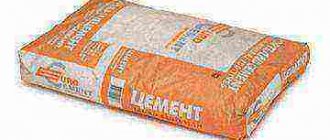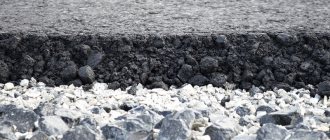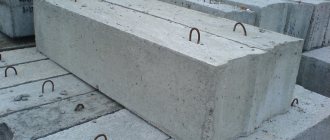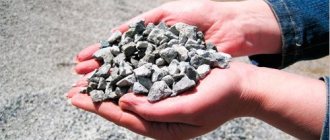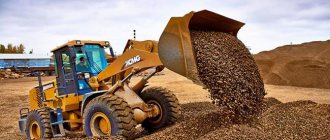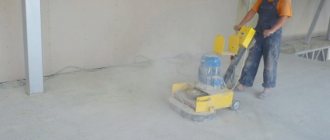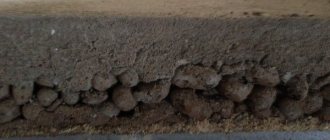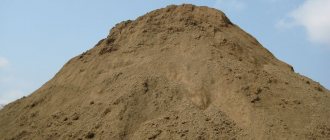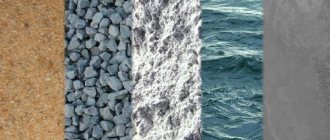Important characteristics of crushed stone
Bulk density – weight 1 cubic meter.
m of crushed stone in an uncompacted state. It is indicated in the certificate of conformity and is different for different fractions and types of material. For example, limestone is the lightest due to its layered and porous structure, while granite is the heaviest due to its high density. If it is not possible to familiarize yourself with the certificates, be guided by approximate indicators in accordance with GOST 8267-93, GOST 8269.0-97. Table 1. Bulk density of crushed stone of different types
| Crushed stone | Fraction size, mm | Bulk density, kg/m3 |
| Granite | 20 – 40 | 1370 – 1470 |
| 40 – 70 | 1380 – 1450 | |
| 70 – 250 | 1400 | |
| Limestone | 10 – 20 | 1250 |
| 20 – 40 | 1280 | |
| 40 – 70 | 1330 | |
| Gravel | 0 – 5 | 1600 |
| 5 – 20 | 1430 | |
| 20 – 40 | 1400 | |
| 40 – 100 | 1650 | |
| >160 | 1730 | |
| Slag | regardless of particle size | 800 |
Before calculating how much crushed stone is needed per area, analyze the associated factors. The main one is the compaction coefficient. This dimensionless value characterizes how much the volume of the material will decrease when compacted with a roller or during natural compaction during transportation. GOST 8267-93 does not require mandatory indication of this parameter in the accompanying documents, so be guided by the conditions of SNiP 3.06.03-85:
- when transported in a truck, the coefficient is 1.1;
- when compacting high-strength grades of granite and crushed gravel – about 1.3;
- when compacting materials of grades 300 – 600 – up to 1.52.
The indicator is relevant for bulk materials with fraction sizes of 40 – 70 and 70 – 120 mm. For other types it is usually not used, since in road construction work fine crushed stone is used for decluttering (filling voids), and not for arranging foundations. However, a foundation cushion is made from it, and crushed stone of 20 - 40 mm is suitable for these purposes. If you need to calculate crushed stone for the foundation, also use a coefficient of 1.3.
Classification of sizes (fractions)
Crushed stone, depending on the size of the fraction, is divided into the following groups:
- I - up to 5 mm. Strength varies from 100-400,
dust content - up to 25%;
- II - from 5-20 mm. Resistance 1400-1600 and 800-1200;
- III - from 20-40 mm. The building materials belonging to the group are 100% famous. Dust content is 35%. Almost no dust was noticed;
- IV - from 25-60 mm.
Rarely used. Dust content no more than 0.2%, strength 1200;
- V - from 40-70 mm. Dust - 0.70%, strength - up to 1200.
The main stage of crushed stone production is the grinding process, on which the grain size actually depends.
Grinding concerns phases II-IV using special equipment.
Depending on the method, there are a variety of crusher devices:
- jaw
– installation at stage I. The principle of operation is the division of rock between 2 plates;
- centrifugal
- used for the production of the smallest dimensions;
- cone - expensive machines
that produce crushed stone of any size;
- rotary
- actions in which the rock, with very active operation of the mechanism, crushes the material until it falls into calibrated exit slots.
Example calculation for a foundation
Calculating crushed stone for the foundation is extremely simple. First of all, calculate the volume of the crushed stone cushion using the formula:
V= Sh= abh, where: S is area, and h is height, a is length, b is width, h is height.
Since we calculate the volume of crushed stone by area, it is already known to us. It should be multiplied by the thickness of the pillow (recommended value is from 20 to 30 cm). If the dimensions of the monolithic foundation are 6x10 m, and the thickness of the crushed stone layer is 25 cm, calculate the volume:
6 x 10 x 0.25 = 15 cu. m
For the foundation cushion, non-metallic materials are traditionally used with frost resistance ratings of at least F300, durable and resistant to moisture. This is usually granite or gravel. But the first is significantly more expensive, and also has natural radioactivity, so you should build residential buildings using it very carefully (for example, you cannot use it in the construction of walls and ceilings). Bulk density of crushed gravel is 20 – 40 mm – about 1400 kg/cubic. m, and the compaction coefficient in this case is 1.3. Knowing these parameters, let’s make a simple calculation:
1.4 t x 15 cu. m x 1.3 = 27.3 t.
We received a total weight of nonmetallic materials for backfilling of 60 square meters. m area in a layer of 25 cm. To calculate the required volume, divide the resulting value by the bulk density of the material:
27.3 t: 1.4 t/cu.m. m. = 19.5 cubic meters m
Physical characteristics and consumption rates
The varieties of this material are not limited to the above three types. There is also a gradation based on rock, quarry and sedimentary rocks, as well as a separate type of crushed stone - processed from waste building materials: brick, concrete or asphalt.
Crushed stone also differs in configuration; if we take into account the method of production from rocks and limestone, the stone will have many sharp edges and plate-like components. On the other hand, if we take into account the production of crushed stone obtained from stones that are constantly in contact with water, the rounded shapes of such material will be more suitable for decorative purposes.
Based on the predominant amount of crushed stone in the mixture, they are distinguished:
- The smallest particles, the average size of which is no more than 5 mm, are eliminated.
- Medium crushed stone with a fraction from 5 to 25 mm.
- Large type of crushed stone, stone size from 25 to 40 mm.
The main thing that you need to find out before purchasing is the fraction of crushed stone, on which the bulk volume and weight will depend. If you need to quickly calculate how much crushed stone to add to the cement mortar, you can use the data in the following table.
Consumption of crushed stone per m³:
| No.: | Fraction size, mm: | Required quantity, kg/m³: |
| 1. | From 0 to 5. | 1500 |
| 2. | From 0 to 40. | 1530 |
| 3. | From 3 to 10. | 1450 |
| 4. | From 5 to 20. | 1370 |
| 5. | From 20 to 40. | 1410 |
| 6. | From 20 to 60. | 1450 |
| 7. | From 20 to 60. | 1480 |
| 8. | From 20 to 90. | 1470 |
| 9. | From 40 to 70. | 1600 |
Such figures are, of course, approximate, just as any company cannot reliably guarantee the uniformity of the sizes of stone particles. This data will help you navigate when forming cement mortars, but there is also a special category - decorative crushed stone, usually used for finishing floors, for example, in the corridors of public places. For such a case, it is necessary to accurately calculate the consumption of crushed stone per quadrature, so the previous table is not useful here.
Consumption of decorative crushed stone per 1 m²:
| No.: | Fraction size, mm: | Bulk mass, kg/l: | Finished layer thickness, mm: | Required quantity, kg: |
| 1. | From 3 to 5 mm. | 1,3 | 20 | 26 |
| 40 — 50 | 65 | |||
| 80 — 100 | 130 | |||
| 2. | From 5 to 10 mm. | 1,4 | 20 | 28 |
| 40 — 50 | 65 | |||
| 80 — 100 | 130 | |||
| 3. | From 10 to 20 mm. | 1,5 | 20 | 30 |
| 40 — 50 | 75 | |||
| 80 — 100 | 150 | |||
| 4. | From 20 to 40 mm. | 1,65 | 40 — 50 | 82 |
| 80 — 100 | 165 |
A characteristic feature of this material will be a huge range of colors, so any combination will be appropriate and beautiful. The formation of the finishing layer requires greater skill of the performer, therefore the accuracy of the calculations will be more important here.
The main rule of successful construction is a good choice of building materials. The tips in our article will help you choose the right type of crushed stone, as well as calculate the required quantity in advance.
For bulk building materials such as crushed stone, sand, gravel, expanded clay or vermiculite, the specific gravity value corresponds to the amount of rock or grains in the occupied volume. The dimension of this indicator in construction speaks for itself - kg or ton per 1 m3 (according to the IKGSS system or N/m3 in the international SI), but unlike true density, it accurately takes into account all entrained air, both in internal pores and between particles (in this case it is called bulk or bulk). The value of this characteristic depends on many factors, but primarily on the type of raw material and the shape of the fractions. It is determined experimentally in a laboratory or at home; the initial data for the calculation are the mass of crushed stone and the volume it occupies.
The specific gravity value is the starting point when calculating the required amount of materials. When using crushed stone with a higher bulk density, the amount of cement consumption for preparing 1 cubic meter of concrete is reduced and the reliability of the manufactured structures is increased. This is explained both by the tighter fit of the grains to each other and by the presence of heavy particles in the composition. This parameter is also used when calculating the volume of the room for storing crushed stone, the carrying capacity and the number of vehicles for its transportation. Providing the right conditions (covered warehouse, ventilation) is an important requirement - the slightest rain leads to moisture absorption and distortion of indicators.
Factors influencing the specific gravity of crushed stone
The value directly depends on the following criteria and conditions:
1. The true density of the rock. The weight of one cube of a solid piece of granite reaches 2.6 tons, dolomite raw materials - 1.8. Accordingly, in a crushed state, these varieties will have different masses.
2. Size of fractions. In relative terms, the difference is small, but obvious: the smaller the diameter of the grains, the more there will be in one cubic meter. But in construction tables, 1 m3 of granite crushed stone with a fraction of 5-20 mm has the same average specific gravity with grades in the range of 20-40 mm or 40-70 mm; you cannot rely only on this indicator.
3. Flakiness. The shape of the particles has a direct effect on the volume of entrained air; its minimum value is observed in cube-shaped crushed stone (most often granite; when crushing limestone or gravel rocks it is difficult to obtain such a variety), the maximum value is observed in the plate-needle category. The proportion of grains with irregular shape in the latest brand is 35-50%, as a result, the volume of intergranular air will be high, which negatively affects the consumption of binder.
4. Moisture absorption, which in turn depends on the porosity of the original rock, the shape and size of the fractions. For hard granite rocks this value is minimal (0.5-0.7% for crushed stone or gravel), for soft calcareous rocks - up to 2.5, for tuff - up to 34. Needle-shaped grains gain more moisture, as a result, if conditions are violated storage, a fraction of 5-20 mm with high flakiness will have a mass higher than that of a similar cube-shaped one.
In practice, the specific gravity of crushed granite or other rocks is influenced by even the most insignificant factors, including the location of the quarry. When purchasing these products, they are taken into account in conjunction with the compaction coefficient.
The material is usually ordered in bulk, most often in cubes; attention is paid to the weight of the purchased volume and the level of its compaction. During transportation, it is compacted; it is recommended to check the actual indicators using a density meter. To eliminate the risk of subsequently selecting incorrect proportions of the remaining components at the construction site, it is important to organize proper storage conditions; for preparing solutions, only dry filler is required.
Calculation of crushed stone for the road
Using the above formulas, it is easy to understand how to calculate the amount of crushed stone for the road. Just plug in the required values:
V = S surface area x h layer thickness
Multiply the resulting volume with the bulk density of crushed stone (usually granite 70 - 120 mm is used) and a coefficient of 1.3 according to the formula:
m = V x beat. density x coefficient seals
Then divide the mass by the specific density and get the volume of crushed stone that needs to be purchased for construction work.
The value of crushed stone mass used in practice
Most often, when converting crushed stone from cubes to tons
, developers use the average value of the bulk mass of the material, which ranges from 1500 to 1600 kg/m³. Although it is better to use a laboratory indicator found at a granite mining and processing plant.
Technologists and laboratory workers at factories for the production of concrete mixtures and reinforced concrete products also conduct tests to determine the bulk density of the aggregate. The plant technologist needs to know the rules for converting cubes of crushed stone into tons in order to calculate the dosing of materials for concrete production. When switching from winter to summer dosage, this indicator is also taken into account.
How to independently calculate the volume of crushed stone?
In modern construction it is very difficult to do without such an important material as crushed stone. Its use is necessary in the construction of both ordinary residential buildings and public buildings. In addition to the construction of buildings, crushed stone with different size fractions is actively used to create new road surfaces, as well as during the implementation of landscape design projects. The properties of the structure being built and the quality of the created road surface, as well as parameters such as reliability, durability, wear resistance and strength of the structures being created, directly depend on how correctly and competently the calculations of the quantity and type of this building material were made.
To calculate the required amount of crushed stone, you need to know its specific gravity. This information can be obtained from the supplier.
Having knowledge of how to calculate the volume of crushed stone, you can more quickly and competently draw up estimate documentation, calculating exactly the cost of the necessary material. Having such information, it is possible to draw up a schedule for construction work in a short time, ensuring timely delivery of material in the required quantity. In addition, a correct and competent calculation of the required volume of crushed stone or gravel will allow you to calculate in advance the total cost of all work and materials for the construction of a particular structure.
Main characteristics of different types of crushed stone
By the type of its origin, a product such as crushed stone is a construction or even decorative material of non-metallic origin. It is used in repair and construction work as an independent product for the implementation of construction tasks or as a material included in the list of ingredients for mortars when creating a variety of reinforced concrete products, elements or structures. The classification of this material is carried out depending on such factors as the origin or place of its extraction, and depending on the types of minerals.
The main thing, when calculating the volume of crushed stone, we must remember that its consumption and quantity are parameters that directly depend on the type, the average size of its fractions, their shape, their intended purpose in accordance with the type and technical instructions, which indicate the acceptable operating conditions of a particular type of material.
According to the place where the raw materials are extracted, crushed stone can be divided into only three main groups, such as:
- nautical,
- mountain,
- river.
Main characteristics of crushed gravel.
All existing types are characterized by such parameters as high strength properties, increased resistance to wear during operation, and low temperatures. Suppliers of minerals of this type are simply obliged to indicate for each batch of products the level of frost resistance appropriate to its quality. This is a very important parameter because it can influence such properties of the material as its density, the cross-section of its faces and the average dimensions of mineral fractions.
The consumption rates of a particular type of crushed stone are values that are directly dependent on all individual parameters of the material, on the type and size of each of its fractions. Before you begin calculating volumes to solve a particular problem, you should ask about what type of material the material is, how its surfaces were processed, what size its particles are, how many processing cycles the bulk material has gone through (2 or 3), before receiving ready-to-use status.
In the process of compiling the most accurate calculations of the volume of material, the presence of other bulk additives in it should be taken into account. And if there are any, then one should not lose sight of their technical parameters.
Return to contents
Parameters that play an important role in calculations
Table of crushed stone strength indicators.
In the process of preparing for the start of construction of objects that will subsequently be used for various purposes, it is calculation activities that play a special role. Calculations begin with measurements of the future object, with a detailed study of existing documentation, and determination of the conditions under which the finished object will be operated. The project documents must certainly contain data on what parameters the future structure will have, its specific gravity, as well as such a value as the compaction coefficient. To carry out the work, various types of crushed stone, types of material by origin, minerals that are most suitable for solving certain problems, depending on the grain size and basic properties, can be used.
So, for example, it is necessary to take into account that minerals from dolomite weigh 1 cubic meter of 1.5 tons. Well, crushed stone made from granite weighs much more, and the weight of its cubic meter is 1000 kg greater than the weight of dolomite material and amounts to 1.6 tons per 1 m³.
There are significant differences in the calculations, which are also associated with different values of the compaction coefficient.
So, for example, to create an embankment when implementing landscape design projects during road work, this coefficient is 1.3. This value is calculated for both mechanical vibratory ramming and ramming using a roller.
Calculation table for decorative crushed stone per 1 sq. m. area.
Proper selection of the most suitable material by type of origin can also influence the quality of building concrete, which is used to create a foundation as a material for preparatory work. Thus, to create a cushion for the foundation, crushed gravel is considered the most preferable, the grain size of which does not exceed 4 cm. In the composition of concrete, crushed stone is a filler that several times increases the durability of the structures being created, their strength, and minimizes shrinkage and creep of the composition. It is worth noting that adding crushed stone to the solution will reduce the consumption of quite expensive concrete.
In addition, the shape of the material fractions also influences the pouring technology and, therefore, the material consumption. Thus, flat stones or needle-shaped fractions significantly increase material consumption and at the same time reduce the frost resistance and strength of finished structures. It is for this reason that round-shaped minerals with a high level of strength and frost resistance are most preferable for construction work.
Return to contents
Production and use of granite crushed stone
Granite crushed stone is a common material in construction. Depending on the size of the fractions, several groups are distinguished:
- I – fractions up to 5 mm in size , representing granite screenings. dust particles up to 25%. Strength grade 1000-1400;
- II – fractions 5-20 mm . Such granite material is often called "associated material". Dust particles are either completely absent or contained in small quantities. Strength grade 800-1200 and 1400-1600;
- III – fractions 20-40 mm . This is the most common and used size. dust – no more than 0.35%, Strength – 1000;
- IV – fraction size 25-60 mm . Rarely used building material. dust particles – no more than 0.25%. Strength grade 1000-1200;
- V – fractions measuring 40-70 mm . The largest faction. Dust content up to 0.68%. Strength grade 1000-1200.
Physical and mechanical characteristics of granite crushed stone
Grain composition. Determines the homogeneity of the material. The more homogeneous it is, the higher its shrinkage and density characteristics.
clay, dust, impurities and other weak rocks. The fewer impurities and the purer the rock, the more accurately the construction technology is followed. Pure material without impurities has better adhesion to the binder. In addition, the radio-resistant characteristics are higher.
Frost resistance. The ability of building materials to withstand freezing and thawing cycles without destruction.
Flakiness. The grain shape is one of the most important characteristics. Flaky means flat. The most optimal are the cube-shaped fractions, which are obtained with proper crushing.
It follows from this that the lower the flakiness, the higher the characteristics. Sharp and flat rock grains do not lie tightly, do not adhere well to each other, and form voids, which helps to reduce the overall density of the embankment or filling.
Radioactivity. This value determines the property of crushed stone to absorb and emit radiation. The lower this property, the better. Granite crushed stone is considered one of the most radiation-resistant materials. Therefore, in structures that are erected next to radioactively hazardous objects, the use of concrete filled with granite crushed stone is mandatory.
Main characteristics of granite crushed stone:
- Strength – 1400;
- Bulk density – 1.4 t/m3;
- Frost resistance – 300;
- The specific activity of radionuclides corresponds to class I of use.
What is the density of granite crushed stone and its specific gravity?
The meaning of such a concept as the density of granite crushed stone is often used incorrectly. The fact is that the density of crushed stone, like granite, is 2600 kg/m3, but there is also such a thing as the bulk density of crushed granite.
This characteristic determines how much 1 cubic meter weighs. crushed stone in its natural state, that is, taking into account all the existing voids between the grains. This volumetric weight of granite crushed stone depends on the density and fraction of the grain material.
Thus, the larger the size of the fractions, the lower the bulk density will be.
As a rule, the density indicator is taken into account when preparing a concrete solution.
In this case, the higher the bulk density, the less volume of cement mortar needs to be spent, which is a clear cost saving.
The density indicator is also taken into account in the transportation and storage of building materials: knowing this value, you can accurately calculate the required carrying capacity of transport for transportation and the size of storage facilities.
It is also worth considering that during the production of crushed stone, its density is of an average value, and the specific gravity of granite crushed stone is 1.4-1.6 t/m3. However, these data must be taken taking into account the bulk form of the material. Therefore, if we mean crushed granite stone, volumetric weight means “bulk” and is determined in a dry state.
Extraction of granite crushed stone
Extraction of granite crushed stone is carried out in many countries of the world, including Ukraine and Russia. As a rule, mining occurs in a quarry method.
Granite crushed stone is extracted from hard rock with a granular structure. The breed is the most widespread on the planet. Granite rocks were formed as a result of the hardening of magma thrown to the surface.
This rock consists of feldspar, quartz, mica, etc. Very often, the rock can be red in color.
Also, the granite from which crushed stone is made can be gray or pink, depending on the amount of mica and spar it contains.
The crushed granite stone in the photo shows well the color differences and external characteristics. Thanks to dark inclusions, crushed granite is easy to distinguish from other rocks.
Extraction is carried out by blasting rock. To do this, specialists make a deep hole in the rock by drilling and place a blasting charge in it. During a series of explosions, blocks are formed that are broken into small pieces.
If the blocks are large, they explode again. Such work is called “stripping”, that is, it is carried out using the drilling-and-blasting method.
After blasting and breaking, the blocks are moved using special equipment to crushing and screening complexes, where they are crushed taking into account the required fraction size. Thus, granite crushed stone of certain size fractions is produced.
After processing, the size of the fractions varies from 2 to 70 mm. After crushing, the material is sorted, in which large fractions are separated from small ones.
Production of crushed stone from granite
In addition to special crushing of blocks to obtain crushed stone, another production method is sifting the rock in a quarry. Thus, in the process of producing granite slabs or large cobblestones, the production residues are sifted and sorted, forming bulk material - crushed stone.
In the process of crushing blocks, special crushing equipment is used. Depending on the purpose, a jaw, rotary or centrifugal impact crusher can be used.
The cheapest way to crush blocks is a jaw crusher. The operating principle of this equipment is based on crushing, bending, and abrasion of rock between two “cheeks” (plates).
One cheek is stationary, and the second is swinging, driven by a drive mechanism.
The second, most common equipment for producing crushed stone is a rotary crusher. The operating principle of this equipment is to crush rock using a powerful rotary motor. Crushers of this type are very unpretentious and are the best option for obtaining fractions of the desired size.
Another mechanism for crushing raw materials is centrifugal impact equipment.
It can be used as an additional one, intended specifically for producing fine crushed stone used in the production of high-quality concrete and asphalt.
Naturally, with the help of this equipment it is possible to produce building materials of larger fractions, however, it is irrational to use the equipment for this purpose, since it was originally intended for crushing into small fractions.
In addition to stationary equipment, which represents crushing and screening complexes, the production of granite crushed stone uses mobile crushing plants, which are used directly at the site of raw material extraction.
Application of granite crushed stone
Crushed granite is a very common building material, however, taking into account its technical parameters, the scope of its application changes. By and large, crushed rock is most often used as filler for high-strength concrete.
Also, granite crushed stone, the use of which depends on technical parameters, is used in the construction of embankments and in road construction.
For these purposes, when it is necessary to achieve maximum compaction of the ballast, it is recommended to use cube-shaped material.
It is worth considering that the use of fractions containing a large number of needle and flakier grains in the production of concrete mixtures often requires increased cement consumption.
When ballasting railway tracks, fractions of 25-60 mm in size are used only for the construction of main tracks, and for access and stationary tracks - 5-25 mm in size.
Granite crushed stone grains have different sizes and shapes. Therefore, taking into account the size of fractions and flakiness in construction work is a prerequisite.
Fractions 3x8, 5x10, 5x20 and 10x20 are used in the production of concrete and for the construction of bitumen-asphalt pavement. Large size fractions 20x40 and 40x200, which are rubble, are most often used when laying the foundations of buildings, and fractions 20x40, 25x60, 40x70 are used in road construction.
Fractional use of granite crushed stone:
0x5 mm (screening) – the smallest fractions of the rock. Used as decoration for finishing, filling paths, for children's and sports grounds, as a de-icing agent, as well as in landscape design;
3x8, 5x10, 5x20, 10x20 – small fractions. They are the most popular material. It is used in the manufacture of concrete and concrete structures, in foundation work, in the construction of bridge structures, airfield and road surfaces;
20x40 - medium-sized fractions, used in the production of concrete, concrete and reinforced concrete structures, in the construction of railways and roads.
It is also in demand when laying foundations, constructing structures for various purposes, when filling parking lots, roads, and bases for foundations.
When used as a filler in high-quality concrete with a strength of 5-20 MPa, which is necessary for constructing temporary platforms for the operation of heavy special equipment;
25x60 and 40x70 - coarse-grained material is used in the production of concrete, massive concrete structures, as well as in work with large volumes of concrete. In demand in road and railway construction. And in some cases it is even used as a filter element;
40x20 - although it can be produced by crushing rock, it is more often a sorted stone called rubble stone or rubble. This is a building stone, the average length of which is up to 20-30 mm.
The main method of extraction is blasting granite deposits. Used in the construction of retaining walls, foundations, and fences. Often used as a decorative element when finishing swimming pools and ponds.
These are the most common ways to use granite fractions. However, each of the listed fractions has other uses.
Watch the production of granite crushed stone on video:
Source: https://kamni.ws/?p=813
Calculation of material volume: features
In order to calculate the required volume of material needed, for example, to create a base for a foundation or for other work, you must first have the following figures:
Physico-mechanical properties of slag crushed stone.
- The compaction coefficient is a constant value, which can be found out from the regulatory documentation for the corresponding type of material.
- Specific gravity of the material per 1 m³. You can find out this value from the supplier or refer to the quality certificate of such products; this value must certainly be indicated there. It is important to understand that specific gravity does not depend on the size of the fractions, but only on the type of minerals.
- The area of the structure to be created.
Case Study: Nuances
You can calculate the volume of crushed stone required to create a base for a foundation with an area of 1 m² and a thickness of 20 cm. First, calculate the volume of the base, which will be equal to:
0.2 m (thickness)*1 m (length)*1 m (width) = 0.2 m³.
The specific gravity of crushed stone, in this case dolomite grade M1000, is 1.5 tons/m³. The compaction coefficient when compacting the cushion with a roller or vibratory rammer is 1.3.
0.2 m³ (volume of the foundation base) * 1.5 t/m³ (weight of 1 m³ of dolomite M1000) * 1.3 (compaction coefficient) = 0.39 t (required volume of crushed stone).
Formula for calculating the cubic capacity of crushed stone
For various construction works, crushed stone . The main types are granite, gravel, limestone or dolomite. Granite is the most durable and expensive. Its use is advisable in places of high physical stress on the object under construction. These are high-traffic roads, aircraft surfaces, and military sites.
Crushed gravel is less durable and costs less. The main application is housing construction due to the low background radiation.
Limestone crushed stone is used in places with low load on the object being built; foundations for premises no higher than the second floor.
Before starting the construction of any object, you need to know the amount of material, including crushed stone. This is what experts in their field do. In practice, the amount of crushed stone is measured in cubic meters. Due to the difference in the physical characteristics of different types of stone, its specific gravity fluctuates. When using different stones, different quantities are needed. The specific gravity of the material is indicated in the quality certificate; the supplier or manufacturer has it. You also need to know the compacted thickness of the base and the compaction coefficient when using a compaction roller.
The most durable is granite crushed stone . The most universal fraction is 5-20 mm in any type of crushed stone. It is suitable for the construction of roads, airfield pavements, foundations, and building plinths. The less dust and foreign impurities there are in its mass, the better it will bind in the concrete solution.
Types of crushed stone density
When choosing a building material, it is important to know its density - it is determined by the ratio of mass to volume. The finer the grain, the higher its bulk density; it will settle tightly and be compacted, without gaps. The weight of 1m3 of crushed stone is higher, the finer the fraction. You can find out the bulk density at home. It is necessary to weigh the trough where the solution will be. Then pour crushed stone into it - to the brim and weigh it again. Next, calculate using the formula – P = (m2 – m1) : V. Here P is the density, m2 is the weight of the trough with crushed stone, m1 is the weight of the empty trough, V is the volume of the trough, which we find out by multiplying its length, width and height. More accurate calculations are made by specialists in laboratory conditions. During construction work, bulk density is an important indicator. The strength of the objects being built depends on it.
Density indicators (kg/m3) for different types: • granite – 1300-1700; • slag – 800; • limestone – 1250-1300; • gravel – 1350-1450
Calculation of crushed stone cubic capacity
Before starting construction work, it is necessary to clearly calculate how much of a particular material is needed. The quality of the objects being built, the foundation or the road surface depends on this. It is important to consider the compaction coefficient of crushed stone after compaction. This parameter is indicated in the passport by the manufacturer or seller for each batch of goods based on laboratory measurements. This is a standard number, determined by GOST. It indicates how many times crushed stone can be compacted during compaction, i.e. reduce its external volume. According to accepted standards, the compaction coefficient is:
- – Sand and gravel mixture – 1, 2
- – Construction sand – 1.15
- – Crushed gravel – 1.1
The best option for purchasing building materials is to purchase directly from the manufacturer, without a middleman reseller. In this case, you will be provided with the correct types of documents for the purchased goods.
How to calculate the volume of crushed stone
When calculating the volume of material, three main important factors are taken into account:
- – The compaction coefficient is indicated in the accompanying documents for each type.
- – Specific gravity of 1m3 of material. It must be specified in the documents when purchasing the goods. Specific gravity does not depend on the size of the fractions, but only on the type of minerals.
- – The area of the structure being built, its base.
- – Compaction depends on various indicators and on its main characteristics.
- – The average density is 1.4-3 g/cm³ (when compaction is calculated, this indicator is one of the main ones).
- – Flakiness determines the level of plane of the material.
- – All material is sorted into fractions.
- – Frost resistance.
- – Level of radioactivity. For all work, crushed stone of the 1st class can be used, but the 2nd class can only be used for road work.
Crushed stone: classification, density, fractions, specific gravity
Crushed stone is a granular inorganic material that belongs to a non-metallic rock and is extracted from crushed rocks, slag from blast furnace and asbestos production, as well as from boulders.
It is used for construction work as a filler for concrete (full information about concrete can be read here) It is used for laying railway tracks, building roads and arranging landscape design objects.
Classification of crushed stone
Crushed stone is extracted using the explosive method in quarries and then sifted. Classified into types:
- Gravel.
- Granite.
- Dolomite or limestone.
- Marble.
- Slag.
One of the most common and durable is granite, which is used for the production of concrete and is also used in landscape design. The material has a fairly high radioactive background. More details about the extraction of crushed granite stone can be found in the video
reveals all the stages: from blasting rock in a quarry to loading it into wagons.
Gravel has a less radioactive background, but this rock is distinguished by lower strength and cost. It is used for foundation construction and road construction. Formed by sifting rocks. It is divided into 2 types: rounded pebbles (gravel) and crushed (crushed or natural).
Limestone has a low strength index. It is used for backfilling during construction, as well as for the manufacture of reinforced concrete products. Made from sedimentary rock, then crushed.
Marble has a decorative purpose when creating landscape design. Used for exterior and interior decoration of buildings.
Slag is the cheapest type of crushed stone. To produce the material, blast furnace waste slag is used, which is formed during metal smelting. If we compare it with granite, the tensile strength is almost the same: granite has 120 MPa in compression, and slag has 104 MPa. Slag concrete is made from this material.
There is also recycled crushed stone, which is made from construction waste, such as asphalt, brick or concrete. It has a low cost, but in basic parameters it is inferior to materials made from rocks. You can read about the properties of asphalt, its varieties and installation in this article
Density of crushed stone
The main parameter of crushed stone is the density indicator. The strength of the material directly depends on this. For example, limestone has a density of 1300 kg/m3, and granite and gravel - 1400 kg/m3. Slag has the lowest indicator - 800 kg/m3. The indicator depends on the amount of various impurities.
The smaller the fraction (size of rock pebbles), the higher the bulk density of crushed stone. There is air between the bulk grains, which is why the density per cubic meter of material will be higher than the volume of uncrushed rock.
The strength of crushed stone is taken into account in the following cases:
- Mixing concrete mortar during construction. Due to this, you can save more money on cement (Read how to choose cement here)
- Its storage in order to determine the size of the warehouse.
- Transportation to calculate the carrying capacity.
To calculate density, the formula is used:
P = (m2 - m1) / V,
where P is the density of building crushed stone;
m2 is the mass of the container in which the material is placed;
m1 is the mass of the empty container;
V is the volume of the container.
The indicator is calculated in laboratory conditions. The material is pre-crushed, dried, and then weighed. As a result, the bulk density is almost half that of the true one. For example, crushed pebbles up to 20 mm in size have an indicator of about 1320 kg/m3, and before crushing - 2600 kg/m3.
But it is necessary to change the external volume of crushed stone when compacting during construction, taking into account the compaction coefficient. This number is determined according to GOSTs and SNiPs.
Compaction factor calculation
According to existing standards, the compaction coefficient (Ku) for crushed stone is 1.1. It is equal to the ratio of the actual density level to the maximum. For example, if the density of crushed gravel is 1400 kg/m3, but it is necessary to reduce it to 1350 kg/m3, then:
Ku = 1350 kg/m3 / 1400 kg/m3 = 0.96.
The resulting value does not exceed existing standards.
Another way to determine the density coefficient is using a special device (density meter). The tip of the equipment, which is held vertically, is immersed in the mixture with pressure. The value is determined by the level of deviation of the indicator arrow.
The device is removed and the reading is recorded in a log. Then measurements are taken at several more points in increments of 15 cm. After this, the average number is displayed and a special schedule is drawn up for the equipment, from which the required coefficient is determined.
If you correctly calculate the compaction coefficient, you can predict further shrinkage of crushed stone, which will determine the stability of the building or road surface.
The compaction coefficient may change due to the following reasons:
- Transportation, from which it is compacted under the influence of its own weight.
- Flakiness. This parameter increases the ability of needle-shaped stones to shrink more than cuboid stones.
- Loading method. The indicator changes if backfilling is done from a great height.
According to the crushed stone laying technology, compaction is carried out layer by layer with constant monitoring. For compaction, a vibrating plate or mechanical roller is usually used. The process can also be done manually.
Depending on the crushed stone fractions, the compaction coefficient has different values.
Separation of crushed stone into fractions
Depending on the maximum particle size, crushed stone is divided into fractions into:
- Extra-large includes 2 types: 70-120, 120-150 mm.
- Large 40-70 mm.
- Average 20-40 mm.
- Small includes 2 types: 5-10, 10-20 mm.
- Screening up to 5 mm.
Screenings are formed after sieving the building material. Such material does not belong to crushed stone, but is its by-product during production. It is used for laying paving slabs, landscaping areas, sports and children's playgrounds, as well as for decorative purposes.
Fine is used for laying asphalt, as well as for pouring bridge structures. Reinforced concrete structures are made from medium-sized fractions, and concrete is also produced.
Large crushed stone is used for:
- Entrance devices.
- Construction of railway embankments, as well as tram lines.
- Construction of buildings during foundation laying.
- Construction of highway cushions.
Large crushed stone is crushed into small fractions if necessary. Extra-large is used for decorative purposes in the manufacture of fences or pools.
Specific gravity of crushed stone
To determine the specific gravity of crushed stone, you need to know its weight in 1 m3. This indicator depends on the size of the rock fraction. You can compare the indicators in the table.
Table. Volumetric weight of crushed stone by fractions.
Crushed stone by fraction, mmSpecific gravity, t/m3
| up to 5 | 1,41 |
| 10 | 1,38 |
| 20 | 1,35 |
| 25 | 1,38 |
| 20-40 | 1,35 |
| 25-60 | 1,37 |
| 40-70 | 1,35 |
Type of rock used. In addition to the size of the fractions, the main factors determining the weight of 1 ton of crushed stone per 1 m3 are:
- Water absorption.
- Flakiness.
The latter indicator depends on the needleness and lamellarity. This indicates the presence of voids, so the specific gravity will be less. And if you take cuboid material, the indicator will increase. If the rock structure is porous, the weight can increase by up to 10% and introduce errors in measurements.
To calculate the mass of crushed stone per volume, it is necessary to average the density (for example, for granite 2600 kg/m3), multiply by its fullness. The void content of this material is 43%, so the fullness is 57% (100 - 43 = 57%). Specific density of granite:
2600 * 0.57 = 1482 kg/m3
From the example it follows that 1 cube of gravel will weigh 1.4 tons.
Calculation of crushed stone for the foundation
First, we determine the required amount of crushed stone per cubic meter. For example, the thickness of the layer should be 20 cm. Next, we obtain the volume using the formula: multiply the width by the length and height, that is, in this case, 1 m x 1 m x 0.2 m = 0.2 m3.
Multiply the resulting number by the specific gravity of crushed stone and the compaction coefficient. In this case, 0.2 m3 x 1.47 t (for crushed granite) x 1.3 = 0.382 m3. This is the consumption of material per cubic meter of foundation. Multiply this number by the total area of the foundation - and you will find out the exact amount of crushed stone that will be needed to create the entire structure.
Concrete for the foundation must be at least M300 or class B25
The composition of such concrete in proportions is as follows:
- – Cement M 400 -380kg
- – Crushed stone - 1080 kg
- – Sand - 705 kg
- – Water 220l.
This is the consumption per 1 m3
Application of material
In industrial construction, granite crushed stone is usually used, which is distinguished by its high strength characteristics. Depending on the type of structure and purpose, it may be more advisable to use lighter and more affordable types of this material.
The main areas of application of crushed stone in construction:
- Concrete solutions for various purposes: from monolithic foundations to the formation of individual foam and gas blocks.
- Road construction: for laying asphalt and paving pedestrian sidewalks. Even when creating an ordinary garden path, this material is used.
- Formation of railway embankments.
- For airport runways.
- Drainage and hydraulic structures.
- Landscape design: creation of decorative embankments and flower beds, design of artificial reservoirs.
As you can see, the use of crushed stone is wide, especially since the variety of shapes and colors allows it to be used even for decorative purposes. The main purpose of this material is to strengthen concrete mortars and is successfully used in home construction.
Concrete made from cement M 400, mixture proportions:
| No.: | Concrete grade: | Volume of concrete, l: | ||||
| Crushed stone, kg: | Sand, kg: | Crushed stone, l: | Sand, l: | |||
| 1. | 100 | 70 | 46 | 61 | 41 | 78 |
| 2. | 150 | 57 | 35 | 50 | 32 | 64 |
| 3. | 200 | 48 | 28 | 42 | 25 | 54 |
| 4. | 250 | 39 | 21 | 34 | 19 | 43 |
| 5. | 300 | 37 | 19 | 32 | 17 | 41 |
| 6. | 400 | 27 | 12 | 24 | 11 | 31 |
| 7. | 450 | 25 | 11 | 22 | 10 | 29 |
Concrete made from cement M 500, mixture proportions:
| No.: | Concrete grade: | Mass composition for 10 kg cement: | Volumetric composition per 10 liters of cement: | Volume of concrete, l: | ||
| Crushed stone, kg: | Sand, kg: | Crushed stone, l: | Sand, l: | |||
| 1. | 100 | 81 | 58 | 71 | 53 | 90 |
| 2. | 150 | 66 | 45 | 58 | 40 | 73 |
| 3. | 200 | 56 | 35 | 49 | 32 | 62 |
| 4. | 250 | 45 | 26 | 39 | 24 | 50 |
| 5. | 300 | 43 | 24 | 37 | 22 | 47 |
| 6. | 400 | 32 | 16 | 28 | 14 | 36 |
| 7. | 450 | 29 | 14 | 25 | 12 | 32 |
The finished concrete composition is distinguished by its strength and durability, in which solid fillers play an important role: sand and crushed stone of various fractions.
